 W
WRichard E. Blanton is an American anthropologist, archaeologist, and academic. He is most renowned for his archaeological field and theoretical research into the development of civilizations in pre-Columbian Mesoamerica, particularly those from the central Mexican plateau and Valley of Oaxaca regions. Blanton taught at Rice University and Hunter College of the City University of New York before joining the faculty at Purdue University in 1976. He is currently Professor Emeritus of Anthropology at Purdue's College of Liberal Arts.
 W
WLorenzo Boturini Benaducci 1698, Sondrio, Italy – 1749, Madrid) was a historian, antiquary and ethno grapher of New Spain, the Spanish Empire's colonial dominions in North America.
 W
WAbbé Charles-Étienne Brasseur de Bourbourg was a noted French writer, ethnographer, historian, archaeologist, and Catholic priest. He became a specialist in Mesoamerican studies, travelling extensively in the region. His writings, publications, and recovery of historical documents contributed much to knowledge of the region's languages, writing, history and culture, particularly those of the Maya and Aztec civilizations. However, his speculations concerning relationships between the ancient Maya and the lost continent of Atlantis inspired Ignatius L. Donnelly and encouraged the pseudo-science of Mayanism.
 W
WDavíd Lee Carrasco is an American academic historian of religion, anthropologist, and Mesoamericanist scholar. As of 2001 he holds the inaugural appointment as Neil L. Rudenstine Professor of Latin America Studies at the Harvard Divinity School, in a joint appointment with the Faculty of Arts and Sciences' Department of Anthropology at Harvard University. Carrasco previously taught at the University of Colorado, Boulder and Princeton University and is known for his research and publications on Mesoamerican religion and history, his public speaking as well as wider contributions within Latin American studies and Latino/a studies. He has made statements about Latino contributions to US democracy in public dialogues with Cornel West, Toni Morrison, and Samuel P. Huntington. His work is known primarily for his writings on the ways human societies orient themselves with sacred places.
 W
WFrancisco Cervantes de Salazar was a Spanish man of letters and rector of the Royal and Pontifical University of Mexico, founded in 1551.
 W
WInga Clendinnen, was an Australian author, historian, anthropologist, and academic.
 W
WDiego Durán was a Dominican friar best known for his authorship of one of the earliest Western books on the history and culture of the Aztecs, The History of the Indies of New Spain, a book that was much criticised in his lifetime for helping the "heathen" maintain their culture.
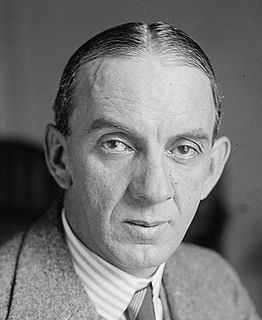 W
WManuel Gamio (1883–1960) was a Mexican anthropologist, archaeologist, sociologist, and a leader of the indigenismo movement. Although he rejected full sovereignty for indigenous communities in Mexico, he argued that their self-governing organizations, such as tribal governments, municipal organizations, and elected community leaders should be recognized and respected. He is often considered as the father of modern anthropological studies in Mexico. He devised a well-known system for classifying the hunter-gatherers of Central America.
 W
WJoaquín García Icazbalceta was a Mexican philologist and historian. He edited writings by Mexican writers who preceded him, wrote a biography of Juan de Zumárraga, and translated William H. Prescott's Conquest of Mexico. His works on Colonial Mexico continue to be cited today.
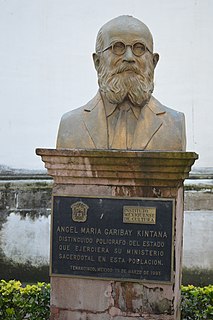 W
WFray Ángel María Garibay Kintana was a Mexican Roman Catholic priest, philologist, linguist, historian, and scholar of pre-Columbian Mesoamerican cultures, specifically of the Nahua peoples of the central Mexican highlands. He is particularly noted for his studies and translations of conquest-era primary source documents written in Classical Nahuatl, the lingua franca of Postclassic central Mexico and the then-dominant Aztec empire. Alongside his former student Miguel León-Portilla, Garibay ranks as one of the pre-eminent Mexican authorities on the Nahuatl language and its literary heritage, and as one who has made a significant contribution towards the promotion and preservation of the indigenous cultures and languages of Mexico.
 W
WGiovanni Francesco Gemelli Careri (1651–1725) was a seventeenth-century Italian adventurer and traveler. He was among the first Europeans to tour the world by securing passage on ships involved in the carrying trade; his travels, undertaken for pleasure rather than profit, may have inspired Around the World in Eighty Days. Some suspected him of spying for the Vatican on his journey.
 W
WAntonio de León y Gama (1735–1802) was a Mexican astronomer, anthropologist and writer. When in 1790 the Aztec calendar stone was discovered buried under the main square of Mexico City, he published an essay about it, Descripción histórica y cronológica de las dos piedras que con ocasión del nuevo empedrado que se está formando en la plaza principal de México, se hallaron en ella el año de 1790 explaining the functioning of aztec calendars.
 W
WMiguel León-Portilla was a Mexican anthropologist and historian.
 W
WFrancisco López de Gómara was a Spanish historian who worked in Seville, particularly noted for his works in which he described the early 16th century expedition undertaken by Hernán Cortés in the Spanish conquest of the New World. Although Gómara himself did not accompany Cortés, and had in fact never been to the Americas, he had firsthand access to Cortés and others of the returning conquistadores as the sources of his account. However other contemporaries, among them most notably Bernal Díaz del Castillo, criticised his work as being full of inaccuracies, and one which unjustifiably sanitised the events and aggrandised Cortés' role. As such, the reliability of his works may be called into question; yet they remain a valuable and oft-cited record of these events.
 W
WLeonardo Náuhmitl López Luján is an archaeologist and one of the leading researchers of pre-Hispanic Central Mexican societies and the history of archaeology in Mexico. He is director of the Templo Mayor Project in Mexico's National Institute of Anthropology and History (INAH) since 1991 and son of renowned historian Alfredo López Austin.
 W
WEduardo Matos Moctezuma is a Mexican archaeologist. From 1978 to 1982 he directed excavations at the Templo Mayor, the remains of a major Aztec pyramid in central Mexico City.
 W
WAndrés de Olmos was a Spanish Franciscan priest and grammarian and ethno-historian of Mexico's indigenous languages and peoples. He was born in Oña, Burgos, Spain and died in Tampico in New Spain. He is best known for his grammar, the first in the New World, of the Classical Nahuatl language.
 W
WWilliam Hickling Prescott was an American historian and Hispanist, who is widely recognized by historiographers to have been the first American scientific historian. Despite suffering from serious visual impairment, which at times prevented him from reading or writing for himself, Prescott became one of the most eminent historians of 19th century America. He is also noted for his eidetic memory.
 W
WBernardino de Sahagún was a Franciscan friar, missionary priest and pioneering ethnographer who participated in the Catholic evangelization of colonial New Spain. Born in Sahagún, Spain, in 1499, he journeyed to New Spain in 1529. He learned Nahuatl and spent more than 50 years in the study of Aztec beliefs, culture and history. Though he was primarily devoted to his missionary task, his extraordinary work documenting indigenous worldview and culture has earned him the title as “the first anthropologist." He also contributed to the description of the Aztec language Nahuatl. He translated the Psalms, the Gospels, and a catechism into Nahuatl.
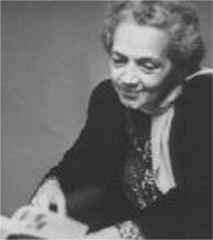 W
WLaurette Séjourné was a Mexican archeologist and ethnologist best known for her study of the civilizations of Teotihuacan and the Aztecs and her theories concerning the Mesoamerican culture hero, Quetzalcoatl.
 W
WDon Carlos de Sigüenza y Góngora was one of the first great intellectuals born in the New World - Spanish viceroyalty of New Spain. He was a criollo patriot, exalting New Spain over Old. A polymath and writer, he held many colonial government and academic positions. Sigüenza is considered the "Da Vinci mexicano"
 W
WJacques Soustelle was an important and early figure of the Free French Forces, an anthropologist specializing in Pre-Columbian civilizations, and vice-director of the Musée de l'Homme in Paris in 1939. Governor General of Algeria, he helped the rise of Charles de Gaulle to the presidency of the Fifth Republic, but broke with De Gaulle over Algerian independence, joined the OAS in their efforts to overthrow De Gaulle and lived in exile between 1961 and 1968. On returning to France he resumed political and academic activity and was elected to the Académie française in 1983.
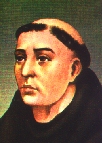 W
WToribio of Benavente, O.F.M., also known as Motolinía, was a Franciscan missionary who was one of the famous Twelve Apostles of Mexico who arrived in New Spain in May 1524. His published writings are a key source for the history and ethnography of the Nahuas of central Mexico in the immediate post-conquest period as well as for the challenges of Christian evangelization. He is probably best known for his attacks on the Dominican defender of the rights of the indigenous peoples, Bartolomé de las Casas, who criticized the Conquest. Though agreeing with Las Casas's criticism of the abuses of the conquistadors, he did not agree with the whole sale condemnation of the Spanish Conquest, as well as his criticisms of the Franciscan practices of baptism en masse of the indigenous people of the new world. Due to these differences he went on to vilify Las Casas.
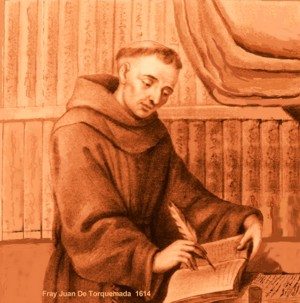 W
WJuan de Torquemada was a Franciscan friar, active as missionary in colonial Mexico and considered the "leading Franciscan chronicler of his generation." Administrator, engineer, architect and ethnographer, he is most famous for his monumental work commonly known as Monarquía indiana, a survey of the history and culture of the indigenous peoples of New Spain together with an account of their conversion to Christianity, first published in Spain in 1615 and republished in 1723. Monarquia Indiana was the "prime text of Mexican history, and was destined to influence all subsequent chronicles until the twentieth century." It was used by later historians, the Franciscan Augustin de Vetancurt and most importantly by 18th-century Jesuit Francisco Javier Clavijero. No English translation of this work has ever been published.
 W
WGeorge Clapp Vaillant was an American anthropologist.